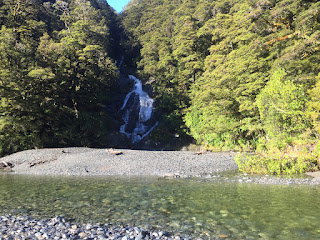I went to
see the multi-award-winning documentary The
Bentley Effect last week. The humble and talented Director, Brendan Shoebridge
and his team (and family) are currently on tour in New Zealand and were supported by the NZ Film Society, The
Green Party and Russell Armitage Arts Management to present their film at the
Lido Cinema, Hamilton. For those who don’t know, Bentley is a small town in
Australia’s New South Wales district of the Northern Rivers. And when corporate
industry rolled out plans for exploiting Coal Seam Gas (CSG) (known commonly as
‘fracking’), the community protested on the grounds of the unknown risks to health
through water contamination and the long-term ecological damage fracking causes. And if you're reading this thinking 'well, no-one in their right mind would be fracking in earthquake-prone New Zealand', then think again and read this.
This documentary showed how Bentley people from all walks of life, and from all over the
affected areas - farmers, businesspeople, landowners, mums, dads, activists,
scientists and students – organised themselves to demonstrate against the invasion
of trucks, machinery and toxic chemicals. An intense education initiative was
launched by the community group through a distribution of flyers, free DVDs of ‘Gasland’ (a 2010 documentary
about the methods involved in fracking) and newspaper articles. Subsequently, a
survey undertaken by the local authorities revealed enormous public opposition
to fracking. This is unsurprising because after all, fracking is effectively a
backward step to unsustainable fossil fuels – there are far safer, less
invasive ways to generate power in the 21st Century. However, the
gas industry and the State Government ignored community concerns in favour of continuing
with potentially profitable deals with landowners. Support for Bentley against
the environmentally damaging policies grew: through social media campaigns,
text alerts, road marches and creative, innovative strategies like knitting
groups, costume parties and a VW campervan rally.
The crucial
strap-line repeated and published on stickers and posters by the community
protestors was ‘lock the gate’ illustrating strength in numbers: if enough
private property owners refused entry to the fracking industry they could
prevent the corporate expansion plans. This was incredibly effective as a
symbolic image, yet it was profoundly sad when someone from the audience
pointed out during the film showing: ‘But we can’t ‘lock the gate’ against helicopters!’
They were referring to the increasing opposition to the Dept of Conservation’s
aerial poisoning operations over New Zealand’s land and waterways in the name
of ‘pest control’. Importantly, and in
contrast to the protests against aerial poisoning here, the Bentley group did
not engage in any dialogue between parties about the scientific evidence for/against
fracking; the chants from hundreds of voices during protests simply repeated ‘No,
means NO!’
 |
| 'Knitting Nanna' Anne Thompson shows her lock. Photo David Lowe |
 |
| Image from Mission Magazine: How fracking happens |
Over five
years passed; the CSG industry had been slowed down, but not yet stopped. The
documentary summarised the numerous dramatic road blockades that took place until
eventually, the battle lines were drawn in the Bentley farming valley. Literally
thousands of people flocked to the improvised (but highly organised) campsite
to try to overcome the threat from 850 riot police who had been bussed-in and ordered
to break-up the peaceful protest. Individuals handcuffed themselves to trucks
or dug themselves into trenches under roads; some tied themselves to trees with
their campaign knitting!
 |
| An image from the film trailer |
But whether the protesters took dramatic, personal risks
or just held hands and sang together against the corporate invasion, they all
shared a passion about keeping their unique part of Australia gasfield-free.
They knew that no matter how small their part in the protest, that they must try
and support the fight. And in the end, their hard work for social justice won
through. This inspiring story shows how a community’s committed, peaceful and heroic
stand with direct and strategic actions of ‘civil disobedience’ can overcome
industrial strength and political short-termism. It is a strong message for our
small population in New Zealand: stand up and be counted, or risk losing the natural
environment we all love and depend upon.
Wherever we
live in New Zealand (and elsewhere) we are up constantly facing all kinds of
pressures to retain our safe, poison-free natural environment. Whether
it’s CSG, deep
sea oil mining, intensive
agriculture, mineral
mining in Conservation land , fluoridation
or aerial poisoning operations, these schemes
jeopardise our land, water and inevitably our food chain. It is
time to stop the widespread acceptance of gravy-trainers, conflicts of
interest, ignorance and bureaucracy and demand
accountability. Our environment is the central source of all our health and
well-being - now and for our future generations, embedded in the Treaty of
Waitangi through the Māori world-view Kaitiakitanga.
Are YOU going to stand by and be over-ruled by greedy Governments and
commercial profits? Or, like the people of Bentley, are you going to take back
control peacefully, feel empowered and ensure your voice counts too?
Thanks to Brendan for his altruistic visit here. If you can get to a screening near you (or organise another one) I urge you to go!



































